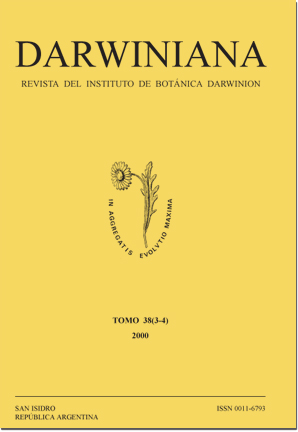Studies on structural variation of the synflorescence of Axonopus (Poaceae, Panicoideae, Paniceae): typology and evolutionary trends
DOI:
https://doi.org/10.14522/darwiniana.2014.383-4.167Keywords:
Poaceae, Paniceae, Axonopus, Inflorescence, Synflorescence, Typology, EvolutionAbstract
Synflorescence typology of Neotropical genus Axonopus P. Beauv. was studied using the methodology and the terminology of Troll’s school. Fifty two species of ca. 75 species of Axonopus were analized. In all taxa the synflorescence is polytelic and truncate. According to this study, the plesiomorphic flowering unit is found in the series Barbigeri G. A. Black. The synflorescence could bederived from an ancestral form by the following evolutionary steps: 1.- truncation of the main axis; 2.- complete homogenization; 3.- reduction of the short paracladia; 4.- decrease of the number of long paracladia; 5.- truncation of the long paracladia. Morphological relationships are discussed and some probable evolutionary trends are outlined.
Downloads
How to Cite
Giraldo-Cañas, D. Studies on structural variation of the synflorescence of Axonopus (Poaceae, Panicoideae, Paniceae): typology and evolutionary trends. Darwiniana, Nueva Serie, 38(3-4), 209–218. https://doi.org/10.14522/darwiniana.2014.383-4.167
Issue
Section
Anatomy and Morphology
License

Starting on 2012, Darwiniana Nueva Serie uses Licencia Creative Commons Atribución-NoComercial 2.5 Argentina .






